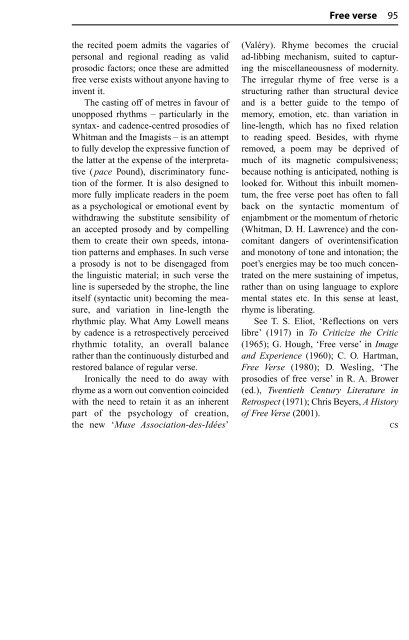The Routledge Dictionary of Literary Terms
The Routledge Dictionary of Literary Terms
The Routledge Dictionary of Literary Terms
You also want an ePaper? Increase the reach of your titles
YUMPU automatically turns print PDFs into web optimized ePapers that Google loves.
the recited poem admits the vagaries <strong>of</strong><br />
personal and regional reading as valid<br />
prosodic factors; once these are admitted<br />
free verse exists without anyone having to<br />
invent it.<br />
<strong>The</strong> casting <strong>of</strong>f <strong>of</strong> metres in favour <strong>of</strong><br />
unopposed rhythms – particularly in the<br />
syntax- and cadence-centred prosodies <strong>of</strong><br />
Whitman and the Imagists – is an attempt<br />
to fully develop the expressive function <strong>of</strong><br />
the latter at the expense <strong>of</strong> the interpretative<br />
( pace Pound), discriminatory function<br />
<strong>of</strong> the former. It is also designed to<br />
more fully implicate readers in the poem<br />
as a psychological or emotional event by<br />
withdrawing the substitute sensibility <strong>of</strong><br />
an accepted prosody and by compelling<br />
them to create their own speeds, intonation<br />
patterns and emphases. In such verse<br />
a prosody is not to be disengaged from<br />
the linguistic material; in such verse the<br />
line is superseded by the strophe, the line<br />
itself (syntactic unit) becoming the measure,<br />
and variation in line-length the<br />
rhythmic play. What Amy Lowell means<br />
by cadence is a retrospectively perceived<br />
rhythmic totality, an overall balance<br />
rather than the continuously disturbed and<br />
restored balance <strong>of</strong> regular verse.<br />
Ironically the need to do away with<br />
rhyme as a worn out convention coincided<br />
with the need to retain it as an inherent<br />
part <strong>of</strong> the psychology <strong>of</strong> creation,<br />
the new ‘Muse Association-des-Idées’<br />
Free verse 95<br />
(Valéry). Rhyme becomes the crucial<br />
ad-libbing mechanism, suited to capturing<br />
the miscellaneousness <strong>of</strong> modernity.<br />
<strong>The</strong> irregular rhyme <strong>of</strong> free verse is a<br />
structuring rather than structural device<br />
and is a better guide to the tempo <strong>of</strong><br />
memory, emotion, etc. than variation in<br />
line-length, which has no fixed relation<br />
to reading speed. Besides, with rhyme<br />
removed, a poem may be deprived <strong>of</strong><br />
much <strong>of</strong> its magnetic compulsiveness;<br />
because nothing is anticipated, nothing is<br />
looked for. Without this inbuilt momentum,<br />
the free verse poet has <strong>of</strong>ten to fall<br />
back on the syntactic momentum <strong>of</strong><br />
enjambment or the momentum <strong>of</strong> rhetoric<br />
(Whitman, D. H. Lawrence) and the concomitant<br />
dangers <strong>of</strong> overintensification<br />
and monotony <strong>of</strong> tone and intonation; the<br />
poet’s energies may be too much concentrated<br />
on the mere sustaining <strong>of</strong> impetus,<br />
rather than on using language to explore<br />
mental states etc. In this sense at least,<br />
rhyme is liberating.<br />
See T. S. Eliot, ‘Reflections on vers<br />
libre’ (1917) in To Criticize the Critic<br />
(1965); G. Hough, ‘Free verse’ in Image<br />
and Experience (1960); C. O. Hartman,<br />
Free Verse (1980); D. Wesling, ‘<strong>The</strong><br />
prosodies <strong>of</strong> free verse’ in R. A. Brower<br />
(ed.), Twentieth Century Literature in<br />
Retrospect (1971); Chris Beyers, A History<br />
<strong>of</strong> Free Verse (2001).<br />
CS

















